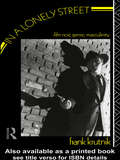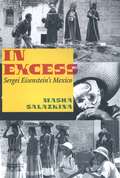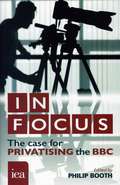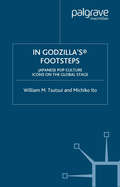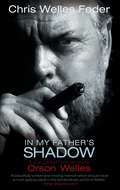- Table View
- List View
Improvised Dance: (In)Corporeal Knowledges
by Nalina WaitThis book elucidates the technical aspects of improvised dance performance and reframes the notion of labour in the practice from one that is either based on compositionally formal logic or a mysterious impulse, to one that addresses the (in)corporeal dimensions of practice. Mobilising the languages and conceptual frameworks of theories of affect, embodied cognition, somatics, and dance, this book illustrates the work of specialist improvisers who occupy divergent positions within the complex field of improvised dance. It offers an alternative narrative of the history and current practice of Western improvised dance centred on the epistemology of its (in)corporeal knowledges, which are elusive yet vital to the refinement of expertise. Written for both a disciplinary-specific and interdisciplinary audience, this book will interest dance scholars, students, and practising artists.
Improvised Dance: (In)Corporeal Knowledges
by Nalina WaitThis book elucidates the technical aspects of improvised dance performance and reframes the notion of labour in the practice from one that is either based on compositionally formal logic or a mysterious impulse, to one that addresses the (in)corporeal dimensions of practice. Mobilising the languages and conceptual frameworks of theories of affect, embodied cognition, somatics, and dance, this book illustrates the work of specialist improvisers who occupy divergent positions within the complex field of improvised dance. It offers an alternative narrative of the history and current practice of Western improvised dance centred on the epistemology of its (in)corporeal knowledges, which are elusive yet vital to the refinement of expertise. Written for both a disciplinary-specific and interdisciplinary audience, this book will interest dance scholars, students, and practising artists.
An Improvised Life: A Memoir
by Alan ArkinAlan Arkin knew he was going to be an actor from the age of five: "Every film I saw, every play, every piece of music fed an unquenchable need to turn myself into something other than what I was." An Improvised Life is the Oscar winner's wise and unpretentious recollection of the process--artistic and personal--of becoming an actor, and a revealing look into the creative mind of one of the best practitioners on stage or screen. In a manner that is direct, down-to-earth, accessible, and articulate, Arkin reveals insights not only about himself (and his audience and students), but also truths for the rest of us about work, relationships, and sense of self.
Improvised Theatre and the Autism Spectrum: A Practical Guide to Teaching Social Connection and Communication Skills
by Gary Kramer Richie PloeschThis guide provides educators, professionals, and parents with an easy-to-follow and comprehensive approach to utilizing improvised theatre as a tool to teach social and communication skills to individuals on the autism spectrum. Opening with the philosophy of the curriculum and the considerations of mental health, play, and environmental factors on individuals with autism, the book then breaks down specific activities, suggests course sequencing, and explains how each activity works and applies to desired outcomes. Packed with dozens of activities and explanations, the book includes all the information necessary to design a full curriculum or create an at-home learning program for parents. By combining the fun and engaging atmosphere of improvisational theatre with the systematic teaching of social skills, professionals and parents can cultivate learning in a way that keeps students engaged while providing long-lasting improvements in social interaction, self-confidence, and communication.
Improvised Theatre and the Autism Spectrum: A Practical Guide to Teaching Social Connection and Communication Skills
by Gary Kramer Richie PloeschThis guide provides educators, professionals, and parents with an easy-to-follow and comprehensive approach to utilizing improvised theatre as a tool to teach social and communication skills to individuals on the autism spectrum. Opening with the philosophy of the curriculum and the considerations of mental health, play, and environmental factors on individuals with autism, the book then breaks down specific activities, suggests course sequencing, and explains how each activity works and applies to desired outcomes. Packed with dozens of activities and explanations, the book includes all the information necessary to design a full curriculum or create an at-home learning program for parents. By combining the fun and engaging atmosphere of improvisational theatre with the systematic teaching of social skills, professionals and parents can cultivate learning in a way that keeps students engaged while providing long-lasting improvements in social interaction, self-confidence, and communication.
Improvisieren: Material, Interaktion, Haltung und Musik aus soziologischer Perspektive (Wissen, Kommunikation und Gesellschaft)
by Silvana Figueroa-DreherDiese Arbeit untersucht Improvisationsprozesse (creativity in performance) aus einer soziologischen Perspektive unter besonderer Berücksichtigung der Dimensionen von Handeln, Interagieren und Wissen. Die Soziologie entwickelte in den letzten Jahren ein zunehmendes Interesse am Phänomen der Improvisation, wobei weniger die Resultate improvisatorischen Handelns im Zentrum standen, als vielmehr die Improvisationsprozesse selbst. Eine solche Fokussierung nimmt auch diese Untersuchung vor. Basierend auf der empirischen, qualitativen und vergleichenden Untersuchung von Free Jazz- und Flamenco-Praktiken sowie in Auseinandersetzung mit der bestehenden Improvisations-, Handlungs-, Interaktions- und Kreativitätsforschung wird hier ein neuartiges Modell des Improvisierens vorgeschlagen, das die diesbezüglichen Handlungs- und Interaktionsprozesse erklärt und die Anschlussfähigkeit für weitere Bereiche der künstlerischen Praxis eröffnet.
Impure Cinema: Intermedial and Intercultural Approaches to Film (World Cinema)
by Lúcia Nagib Anne JerslevAndré Bazin's famous article, 'Pour un cinéma impur: défense de l'adaptation', was first translated into English simply as 'In Defence of Mixed Cinema', probably to avoid any uncomfortable sexual or racial resonances the word 'impure' might have. Impure Cinema goes back to Bazin's original title precisely for its defence of impurity, applying it on the one hand to cinema's interbreeding with other arts and on the other to its ability to convey and promote cultural diversity. In contemporary progressive film criticism, ideas of purity, essence and origin have been superseded by favourable approaches to 'hybridization', 'transnationalism', 'multiculturalism' and cross-fertilizations of all sorts. Impure Cinema builds on this idea in novel and exciting ways, as it draws on cinema's combination of intermedial and intercultural aspects as a means to bridge the divide between studies of aesthetics and culture. Film is revealed here as the location par excellence of media encounters, mutual questioning and self-dissolution into post-medium experiments. Most importantly, the book argues, film's intermedial relations can only be properly understood if their cultural determinants are taken into account. Scholars and students of film, cinéfiles and students of the arts will discover here unexpected connections across many artistic practices.
In a Glamourous Fashion: The Fabulous Years of Hollywood Costume Design (Routledge Revivals)
by W. Robert LaVineFirst published in 1981, In A Glamourous Fashion is not only a fascinating look at film fashion portraying the glamour and glitter of Hollywood’s heyday; but is also an invaluable reference source for any student of the film, of costume, or of the social history. It documents some of the best work of the designers – names like Adrian, Cecil Beaton, Edith Head – but tells the often-dramatic story of their careers and their relationships with legendary stars such as Garbo, Dietrich, Monroe and many more. Here are the stories behind the screen’s most famous costumes: Walter Plunkett’s ‘curtain dress’ for Scarlett O’Hara; the red Jezebel gown Orry-Kelly designed for Bette Davis; the slinky back satin sheath Rita Hayworth wore in Gilda; and the extravagant gown – ₤ 15, 000 worth of mink – worn by Ginger Rogers in Lady in the Dark. The photographs and original sketches are an essential and decorative complement to the text; there is an index, bibliography, and a full list of Academy Award winners for costume design.
In a Glamourous Fashion: The Fabulous Years of Hollywood Costume Design (Routledge Revivals)
by W. Robert LaVineFirst published in 1981, In A Glamourous Fashion is not only a fascinating look at film fashion portraying the glamour and glitter of Hollywood’s heyday; but is also an invaluable reference source for any student of the film, of costume, or of the social history. It documents some of the best work of the designers – names like Adrian, Cecil Beaton, Edith Head – but tells the often-dramatic story of their careers and their relationships with legendary stars such as Garbo, Dietrich, Monroe and many more. Here are the stories behind the screen’s most famous costumes: Walter Plunkett’s ‘curtain dress’ for Scarlett O’Hara; the red Jezebel gown Orry-Kelly designed for Bette Davis; the slinky back satin sheath Rita Hayworth wore in Gilda; and the extravagant gown – ₤ 15, 000 worth of mink – worn by Ginger Rogers in Lady in the Dark. The photographs and original sketches are an essential and decorative complement to the text; there is an index, bibliography, and a full list of Academy Award winners for costume design.
In a Lonely Street: Film Noir, Genre, Masculinity
by Frank KrutnikTaking issue with many orthodox views of Film Noir, Frank Krutnik argues for a reorientation of this compulsively engaging area of Hollywood cultural production. Krutnik recasts the films within a generic framework and draws on recent historical and theoretical research to examine both the diversity of film noir and its significance within American popular culture of the 1940s. He considers classical Hollywood cinema, debates on genre, and the history of the emergence of character in film noir, focusing on the hard-boiled' crime fiction of Dashiell Hammett, Raymond Chandler and James M. Cain as well as the popularisationof Freudian psychoanalysis; and the social and cultural upheavals of the 1940s. The core of this book however concerns the complex representationof masculinity in the noir tough' thriller, and where and how gender interlocks with questions of genre. Analysing in detail major thrillers like The Maltese Falcon, Double Indemnity, Out of the Past and The Killers , alongside lesser known but nonetheless crucial films as Stranger on the Third Floor, Pitfall and Dead Reckoning Krutnik has produced a provocative and highly readable study of one of Hollywood most perennially fascinating groups of films.
In a Lonely Street: Film Noir, Genre, Masculinity
by Frank KrutnikTaking issue with many orthodox views of Film Noir, Frank Krutnik argues for a reorientation of this compulsively engaging area of Hollywood cultural production. Krutnik recasts the films within a generic framework and draws on recent historical and theoretical research to examine both the diversity of film noir and its significance within American popular culture of the 1940s. He considers classical Hollywood cinema, debates on genre, and the history of the emergence of character in film noir, focusing on the hard-boiled' crime fiction of Dashiell Hammett, Raymond Chandler and James M. Cain as well as the popularisationof Freudian psychoanalysis; and the social and cultural upheavals of the 1940s. The core of this book however concerns the complex representationof masculinity in the noir tough' thriller, and where and how gender interlocks with questions of genre. Analysing in detail major thrillers like The Maltese Falcon, Double Indemnity, Out of the Past and The Killers , alongside lesser known but nonetheless crucial films as Stranger on the Third Floor, Pitfall and Dead Reckoning Krutnik has produced a provocative and highly readable study of one of Hollywood most perennially fascinating groups of films.
The In-Between in Javanese Performing Arts: History and Myth, Interculturalism and Interreligiosity (Music / Culture)
by SumarsamThis book is the first comprehensive overview of Javanese performing arts from their origins to their dynamic present. Renowned scholar and musician Sumarsam draws from a lifetime of immersion in both wayang and gamelan to guide readers through the concept of the "in-between," revealing how the interplay of dualisms—myth and history, sacred and secular, personal and cultural—forms the bedrock of Javanese performance. Rigorously researched historical case studies reveal the intricate relationship between histories and mythologies in Java. Wayang, accompanied by gamelan, is a multimedia performance imbued with rich historical, aesthetic, religious, and emotional associations. Sumarsam delves into this intricate, profound, and ever-evolving art form, exploring its diverse manifestations and venues, from courtly village entertainment-cum-ritual to palace-based aesthetic expressions of cultural proficiency; from coastal mercantile entrepots to the verdant wet rice terraces of Java; from colonial plantation and textile factory cultures to communities centered around contemporary industrial estates and creative economy initiatives. An essential resource for scholars, musicians, and enthusiasts of wayang and gamelan, The In-Between in Javanese Performing Arts offers an unparalleled immersion into the heart of traditional Javanese performing arts, revealing their profound impact on Javanese culture, identity, and artistic expression.
In-Between Worlds: Performing [as] Bauls in an Age of Extremism (Routledge Advances in Theatre & Performance Studies)
by Sukanya ChakrabartiThis book examines the performance of Bauls ‘folk’ performers from Bengal, in the context of a rapidly globalizing Indian economy and against the backdrop of extreme nationalistic discourses. Recognizing their scope beyond the musical and cultural realm, Sukanya Chakrabarti engages in discussing the subversive and transformational potency of Bauls and their performances. In-Between Worlds argues that the Bauls through their musical, spiritual, and cultural performances offer ‘joy’ and ‘spirituality,’ thus making space for what Dr. Ambedkar in his famous 1942 speech had identified as ‘reclamation of human personality’. Chakrabarti destabilizes the category of ‘folk’ as a fixed classification or an origin point, and fractures homogeneous historical representations of the Baul as a ‘folk’ performer and a wandering mendicant exposing the complex heterogeneity that characterizes this group. Establishing ‘folk-ness’ as a performance category, and ‘folk festivals’ as sites of performing ‘folk-ness,’ contributing to a heritage industry that thrives on imagined and recreated nostalgia, Chakrabarti examines different sites that produce varied performative identities of Bauls, probing the limits of such categories while simultaneously advocating for polyvocality and multifocality. While this project has grounded itself firmly in performance studies, it has borrowed extensively from fields of postcolonial studies and subaltern histories, literature, ethnography and ethnomusicology, and cosmopolitan studies.
In-Between Worlds: Performing [as] Bauls in an Age of Extremism (Routledge Advances in Theatre & Performance Studies)
by Sukanya ChakrabartiThis book examines the performance of Bauls ‘folk’ performers from Bengal, in the context of a rapidly globalizing Indian economy and against the backdrop of extreme nationalistic discourses. Recognizing their scope beyond the musical and cultural realm, Sukanya Chakrabarti engages in discussing the subversive and transformational potency of Bauls and their performances. In-Between Worlds argues that the Bauls through their musical, spiritual, and cultural performances offer ‘joy’ and ‘spirituality,’ thus making space for what Dr. Ambedkar in his famous 1942 speech had identified as ‘reclamation of human personality’. Chakrabarti destabilizes the category of ‘folk’ as a fixed classification or an origin point, and fractures homogeneous historical representations of the Baul as a ‘folk’ performer and a wandering mendicant exposing the complex heterogeneity that characterizes this group. Establishing ‘folk-ness’ as a performance category, and ‘folk festivals’ as sites of performing ‘folk-ness,’ contributing to a heritage industry that thrives on imagined and recreated nostalgia, Chakrabarti examines different sites that produce varied performative identities of Bauls, probing the limits of such categories while simultaneously advocating for polyvocality and multifocality. While this project has grounded itself firmly in performance studies, it has borrowed extensively from fields of postcolonial studies and subaltern histories, literature, ethnography and ethnomusicology, and cosmopolitan studies.
In Bewegung setzen ...: Beiträge zur deutschsprachigen Animationsforschung
by Franziska Bruckner Erwin Feyersinger Markus Kuhn Maike Sarah ReinerthDer Sammelband analysiert die grundsätzliche Bedeutung, die Animation in unserer medialisierten Welt einnimmt. Animation bewegt Bilder, Emotionen, die Kunst, die Industrie und wandelt auch die Forschung – sie stellt traditionelle Disziplinen und Theorien des (Audio-)Visuellen vor neue Herausforderungen. Die Aufsätze thematisieren signifikante Phänomene in Animationstheorie, -geschichte und -ästhetik wie etwa Hybridität, Bewegungsdarstellungen, Verbindungen von Ton und Bild, Motion Capture, bildgebende Verfahren der Medizin, experimentelle Architekturvisualisierungen oder Werbefilme für Game Engines.
In-Depth Acting (The Actor's Toolkit)
by Dee Cannon Pierce BrosnanA book that will stand the test of time for any actor in the making, a book of knowledge and hard-earned commitment to the art of acting"- Pierce BrosnanAn essential guide to mastering the Stanislavski technique, filtering out the complexities of the system and offering a dynamic, hands-on approach. In-Depth Acting provides a comprehensive understanding of character, preparation, text, subtext and objectives.• How to prepare for drama school and professional auditions• How to develop a 3-dimensional, truthful character• Preparation exercises to help you get in character• Rehearsal guidelines• An appendix of Transitive/Active Verbs and more‘A wonderful, succinct book that no student or professional actor should be without.’ - Jenny Lipman, Acting Tutor at LAMDA‘Dee Cannon’s classes at RADA were legendary. This is an inspiring and intensely practical guide for anyone, at any stage of their acting life.’ - Eve Best‘As a former student of Dee’s, I can assure you that this is the definitive version of the method I use to approach every role: iPods, animals and OBJECTIVES! How wonderful to finally have it all in book form!’ - Gemma Arterton'Working with Dee and with this book I feel my process and preparation has been energized, activated and inspired' - Ramin Karimloo
In eigener Regie: Aktive Medienarbeit mit Jugendlichen (Schriftenreihe des Institut Jugend Film Fernsehen)
by Fernsehen Institut Jugend Film, Fernsehen Institut Jugend FilmIn Excess: Sergei Eisenstein's Mexico (Cinema and Modernity)
by Masha SalazkinaDuring the 1920s and ’30s, Mexico attracted an international roster of artists and intellectuals—including Orson Welles, Katherine Anne Porter, and Leon Trotsky—who were drawn to the heady tumult engendered by battling cultural ideologies in an emerging center for the avant-garde. Against the backdrop of this cosmopolitan milieu, In Excess reconstructs the years that the renowned Soviet director Sergei Eisenstein spent in the country to work on his controversial film ¡Que Viva Mexico! Illuminating the inextricability of Eisenstein’s oeuvre from the global cultures of modernity and film, Masha Salazkina situates this unfinished project within the twin contexts of postrevolutionary Mexico and the ideas of such contemporaneous thinkers as Walter Benjamin. In doing so, Salazkina explains how Eisenstein’s engagement with Mexican mythology, politics, and art deeply influenced his ideas, particularly about sexuality. She also uncovers the role Eisenstein’s bisexuality played in his creative thinking and identifies his use of the baroque as an important turn toward excess and hybrid forms. Beautifully illustrated with rare photographs, In Excess provides the most complete genealogy available of major shifts in this modern master’s theories and aesthetics.
In Excess: Sergei Eisenstein's Mexico (Cinema and Modernity)
by Masha SalazkinaDuring the 1920s and ’30s, Mexico attracted an international roster of artists and intellectuals—including Orson Welles, Katherine Anne Porter, and Leon Trotsky—who were drawn to the heady tumult engendered by battling cultural ideologies in an emerging center for the avant-garde. Against the backdrop of this cosmopolitan milieu, In Excess reconstructs the years that the renowned Soviet director Sergei Eisenstein spent in the country to work on his controversial film ¡Que Viva Mexico! Illuminating the inextricability of Eisenstein’s oeuvre from the global cultures of modernity and film, Masha Salazkina situates this unfinished project within the twin contexts of postrevolutionary Mexico and the ideas of such contemporaneous thinkers as Walter Benjamin. In doing so, Salazkina explains how Eisenstein’s engagement with Mexican mythology, politics, and art deeply influenced his ideas, particularly about sexuality. She also uncovers the role Eisenstein’s bisexuality played in his creative thinking and identifies his use of the baroque as an important turn toward excess and hybrid forms. Beautifully illustrated with rare photographs, In Excess provides the most complete genealogy available of major shifts in this modern master’s theories and aesthetics.
In Fading Light: The Films of the Amber Collective
by James LeggottFor over five decades, the Newcastle-based Amber Film and Photography Collective has been a critical (if often unheralded) force within British documentary filmmaking, producing a variety of innovative works focused on working-class society. Situating their acclaimed output within wider social, political, and historical contexts, In Fading Light provides an accessible introduction to Amber’s output from both national and transnational perspectives, including experimental, low-budget documentaries in the 1970s; more prominent feature films in the 1980s; studies of post-industrial life in the 1990s; and the distinctive perils and opportunities posed by the digital era.
In Focus: The Case For Privatising the BBC
by Booth Et AlThis book makes a persuasive argument that the licence fee is no longer the right way to raise revenue for the BBC. While there was a case for this model when the only way to watch the BBC was through the ownership of a television, and there was no way to prevent anyone who owned a television from watching the BBC, technological developments have demolished this argument. Millennials consume more and more of their broadcast media through a tablet, computer or phone. Yet, non-payment of the licence fee now accounts for 10 per cent of all criminal convictions in the UK, so we may soon be in the invidious position where a majority of young people watch BBC programmes through devices that are not taxed, while older people who own a television but watch only ITV or Sky Sports are taxed and, in the case of non-compliance, subject to arrest. Those who support the continuation of the licence fee often do so using two arguments: that the BBC is vital for producing what has become known as 'public service broadcasting', and that the BBC produces news that is non-partisan together with unbiased coverage of current affairs. The authors of this book challenge both of these arguments and show that there are various ways in which the BBC could be made independent of the state and/or of compulsory funding.
In Focus:the Case For Privatising BBC (PDF)
by Booth Et AlThis book makes a persuasive argument that the licence fee is no longer the right way to raise revenue for the BBC. While there was a case for this model when the only way to watch the BBC was through the ownership of a television, and there was no way to prevent anyone who owned a television from watching the BBC, technological developments have demolished this argument. Millennials consume more and more of their broadcast media through a tablet, computer or phone. Yet, non-payment of the licence fee now accounts for 10 per cent of all criminal convictions in the UK, so we may soon be in the invidious position where a majority of young people watch BBC programmes through devices that are not taxed, while older people who own a television but watch only ITV or Sky Sports are taxed and, in the case of non-compliance, subject to arrest. Those who support the continuation of the licence fee often do so using two arguments: that the BBC is vital for producing what has become known as 'public service broadcasting', and that the BBC produces news that is non-partisan together with unbiased coverage of current affairs. The authors of this book challenge both of these arguments and show that there are various ways in which the BBC could be made independent of the state and/or of compulsory funding.
In Glorious Technicolor: A Century of Film and How it has Shaped Us
by Francine StockFilm is a communal dream in which our fears and fantasies are revealed. It has influenced our behaviour, intertwined with our politics, helped to forge national identity, galvanise communities against a wartime enemy or warn of social upheaval. It has burrowed deep into our psyche, changing perceptions of history and memory, and even raised our romantic expectations.Despite decades of rapid change, we are still hypnotised and seduced by the power of cinema; it remains our most persuasive mass entertainment. In this fascinating, entertaining and illuminating book Francine Stock takes us on a personal journey through a glorious century of cinema, from the Lumiere brothers' flickering train to the 3D excesses of Avatar, showing in vivid detail how film both reflects and remakes our world.
In Godzilla's Footsteps: Japanese Pop Culture Icons on the Global Stage
by W. Tsutsui M. ItoThese essays consider the Godzilla films and how they shaped and influenced postwar Japanese culture, as well as the globalization of Japanese pop culture icons. There are contributions from Film Studies, Anthropology, History, Literature, Theatre and Cultural Studies and from Susan Napier, Anne Allison, Christine Yano and others.
In My Father's Shadow: A Daughter Remembers Orson Welles
by Chris Welles FederOf all the myriad stars and celebrities Hollywood has produced, only a handful have achieved the fame - and, some would say, infamy - of Orson Welles, the creator and star of what is arguably the greatest film ever, Citizen Kane. Many books have been written about him, detailing his achievements as an artist as well as his foibles as a human being. None of them, however, has come so close to the real man as Chris Welles Feder does in this beautifully realised portrait of her father.In My Father's Shadow is a classic story of a life lived in the public eye, told with affection and the wide-eyed wonder of a daughter who never stopped believing that some day she would truly know and understand her elusive and larger-than-life father. The result is a moving and insightful look at life in the shadow of a legendary figure and an immensely entertaining story of growing up in the unreal reality of Hollywood.






